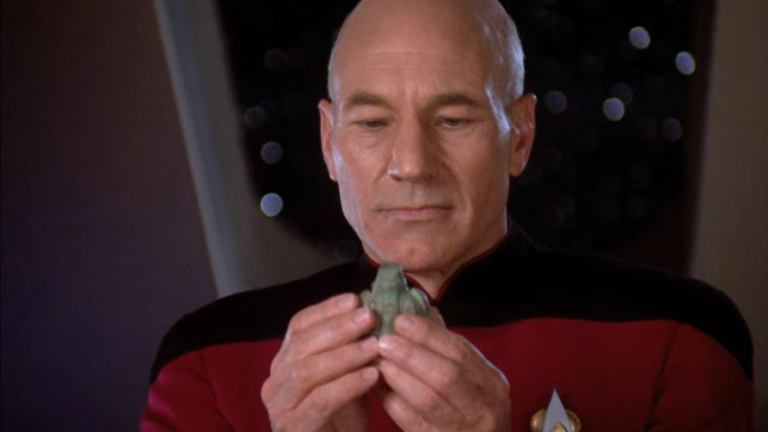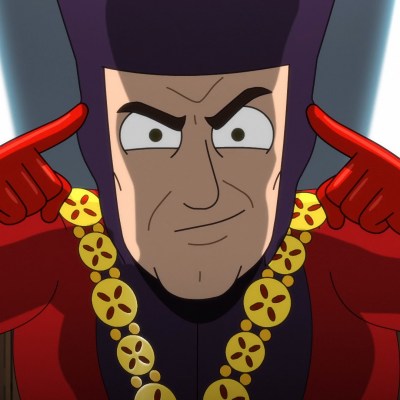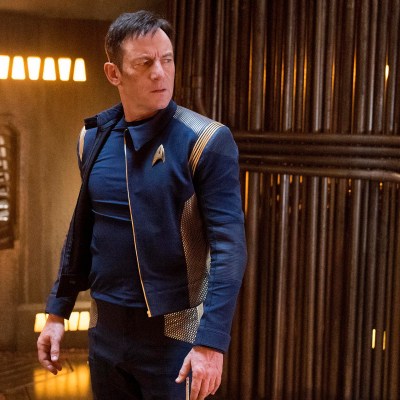How Star Trek: Next Generation’s “The Chase” Changed Canon Forever
Remembering that time when Star Trek: The Next Generation’s pseudo-Indiana Jones episode also redefined the rules of the Final Frontier.

What do space heists and archaeology have in common? The answer is one of the most important and bizarrely under-appreciated episodes of Star Trek: The Next Generation: Season 6 banger, “The Chase.” Written by future Battlestar Galactica showrunner Ronald D. Moore and Joe Menosky, and directed by Jonathan Frakes, “The Chase” is a perfect example of a late-era TNG episode insofar as the characters all feel super-cozy, and the story has a subtle intensity without resorting to a ton of explosions or violence. At the same time, “The Chase” also offered a Watsonian answer to a question with a seemingly very obvious Doyle-ist answer: Why do Star Trek aliens look the way they do? In “The Chase,” we learn all about the rules of Trek aliens, and along the way, the TNG lore is expanded in other big ways, too.
“The Chase” aired on April 26, 1993, and as such, exists in the interesting time when TNG and DS9 were airing new episodes simultaneously. DS9 had already expanded the canon of Trek by permanently parking itself in the histories of both the Bajorians and the Cardassians, but in doing so, DS9 had also brought another Star Trek plot element back into vogue in a big way: The ancient space mystery! These kinds of stories usually focus on a long-dead alien species that had a profound impact on history and influenced everyone’s basic perception of why things are the way they are. In a sense, the entire first season of Star Trek: Picard falls into this story phylum. In the 1993 DS9 pilot, “The Emissary” — which aired just six months before “The Chase” — we learn the ancient gods of Bajor, the Prophets, are really timeless aliens from another plane of existence. This kind of idea is nearly as old as science fiction itself, but prior to DS9, Star Trek did this all the time. The notion of ancient and influentially alien races pops up in TOS a lot, including references to “the Old Ones,” in “What Are Little Girls Made Of?” and “Catspaw.” There’s also Sargon’s race of energy beings from “Return to Tomorrow,” who low-key take credit for the existence of humanoids. This idea also pops up with “the Preservers” in the episode “The Paradise Syndrome.” Before “The Chase,” TNG had a few episodes like this, too, including “The Last Outpost,” and pivotally, the Season 2 episode “Contagion,” the first time we learn that Picard had previously considered a career in archeology before staying on the career path that led to starship captain.
It’s also helpful when those “many voices” can create cool stories. In High Fidelity, John Cusak’s Rob Gordon explains character development like this: “What really matters is what you like, not what you are like… Books, records, films – these things matter!” With Picard, the vastly different interests that feel divergent from his Starfleet persona — hard-boiled noir novels, archaeology — help round him out in a way that you can imagine him as a real person, existing beyond the confines of the TV show. But, prior to “The Chase,” the archaeology thing hadn’t really been explored in any real way. It’s almost like in the final two seasons of TNG, the writers remembered Picard has a cool intellectual superpower called “archaeology.”
After “The Chase,” we get a Season 7 two-parter called “Gambit,” in which Picard goes undercover using his former archeology professor’s name, Galen, to track down—you guessed it—ancient pieces of an alien artifact that could have untold power! The interstellar adventures of Galen Jones never really took off as a TNG spin-off, but again, if you squint, aspects of Star Trek: Picard don’t feel that far off from “The Chase” or “Gambit.” (As post-” Unification” stories, these episodes also double-down on the idea that Picard is personally invested in the history of Romulus and also making peace with the Romulans in general. Thanks, Spock!)
But. The reason why “The Chase” is so important to Star Trek canon isn’t just connected to the ongoing character development of Jean-Luc Picard. Picard’s personal stakes in unlocking an ancient archeology mystery help make the episode move, but the larger revelation of what is going on is slightly cooler. There’s a scene where Picard is describing the four billion-year-old genetic mystery and the camera slowly zooms in on him, really letting you know that this shit is about to get real. It goes like this:
“It’s four billion years old. A computer program from a highly advanced civilization, and it’s hidden in the very fabric of life itself. [SLOW JONATHAN FRAKES ZOOM LENS BEGINS, OMINIOUSLY.] Whatever information this program contains could be the most profound discovery of our time. Or the most dangerous.”
The culmination of “The Chase” is all about various governments trying to unlock the secrets of the genetic computer program to figure out its secrets. This is the Raiders of the Lost Ark stuff. The Klingons think it’s a giant weapon. The Cardassians think it’s an unlimited power supply. Belloq thinks it’s a radio for talking to God, even though nobody invited him. Even the Romulans are in on it, wanting to obtain this four billion-year-old puzzle for themselves. In the end, the big revelation is that all the “humanoid” bipedal species we’ve seen throughout Star Trek were created intentionally by an even more ancient set of humanoids. This tap-dance with real science doesn’t contradict evolution per se, but in the ancient message the ancient humanoid woman says: “Our scientists seeded the primordial oceans of many worlds, where life was in its infancy. The seed codes directed your evolution toward a physical form resembling ours.”
So, the TLDR is that in the Trek universe, we evolved naturally, but only because we were given a push. This is as close the Trek canon will come to the notion of panspermia, the real-life theory that organic life could have been intentionally seeded on Earth. But, Trek alum Ronald D. Moore would revisit this idea in a big way in his famous reboot of Battlestar Galactica. This has all happened before and it will all happen again… sometimes, in a different franchise.
So what’s the big deal with the revelation that all the humanoid alien species share a common ancestor? Well, the knee-jerk answer is that this episode provided bandaid on the slightly unrealistic notion that most aliens in Star Trek just like humans with different foreheads or wrinkled noses or funny ears. And that’s true, “The Chase” does provide a Watsonian answer for why the Star Trek universe looks the way it does, at least when it comes to extraterrestrials. Haters might say this was a bad idea because it called attention to something that doesn’t need explaining, sort of like the Trek version of the midichlorians. But, that negative take misses a slightly larger truth, which debunks an important myth about the foundation of Trek.
The reason why The Original Series mostly tackled aliens who looked like humans in bad make-up is only partially an economic one. Yes, it’s widely impractical to do Hortas and Gorns every week, but in creating the writers’ bible for TOS, Roddenberry also made it clear that humanoid aliens were part of a dramatic choice, not just an economic one. In early pitch documents, Roddenberry describes “the parallel worlds” concept like this: “It means simply that our stories will plant and animals life, plus people, quite similar to that on Earth.”
Roddenberry wasn’t just doing this to save money. The “parallel worlds” concept was clearly something he wanted so the stories would connect with a casual viewer and not just hardcore science fiction fans. Prior to Star Trek, the general perception of filmed science fiction was that it was genre dominated by “Bug-Eyed Monsters.” By introducing the “Parallel worlds” concept, Roddenberry was creating a buffer against the series becoming too much like monster-of-the-week science fiction. Yes, this decision conveniently saved a little bit of money, but it’s very clear that wasn’t the only factor. Even at the beginning, Star Trek wanted to do humanoid aliens not because it was easy, but because telling those stories would be more interesting.
What Moore and Menosky did with “The Chase,” was to come right out and make that dramatic choice into a thoughtful and exciting episode. The physics and biological science of the Star Trek universe might not exactly line up with our own, but the way in which the various shows prioritize people over technology is a relative constant. In “The Chase,” TNG reminded everyone that Star Trek was always about telling stories about people, even if those people were literally aliens. In this way, “The Chase” didn’t so much as change canon, but rather, clarified it. The reason why the Romulans, Humans, Cardassians look the way they do has an answer. But the real answer to that question requires even more introspection than the episode has time for. Which, in a nutshell, is what a lot of good Trek is supposed to do. “The Chase” is both an overt metaphor and a hardcore in-universe story at the same time. Many voices, inside the one.
Editor’s note: Norman Lloyd, the actor who played Professor Galen in “The Chase” (and inhabited many, many other roles in his long career) passed away earlier this week. You can learn more about his life and career here.


